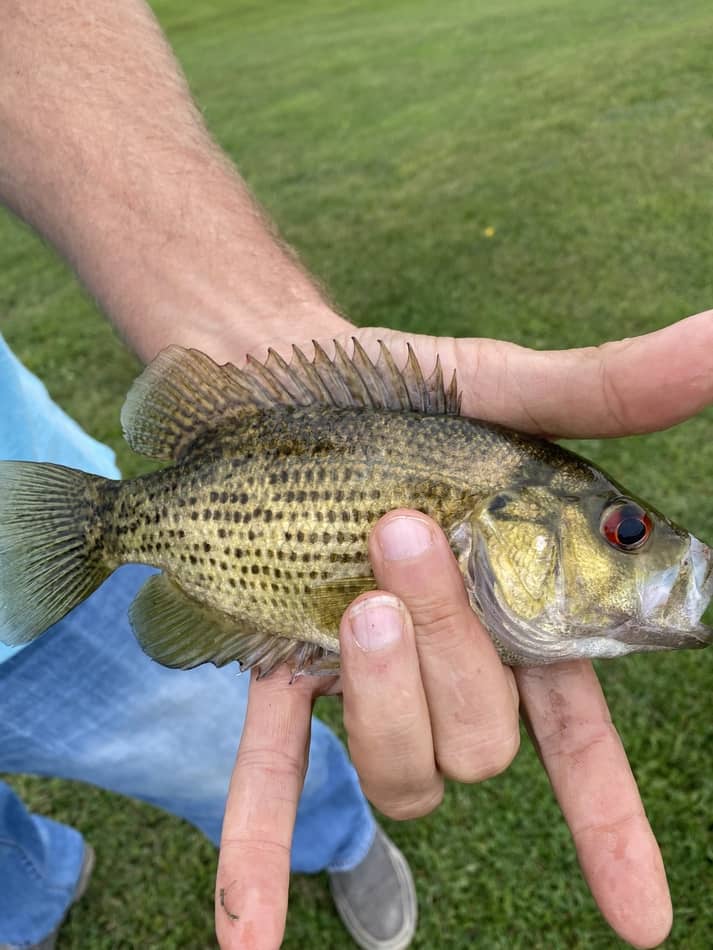
Rock Bass are an easy fish to catch making a great fish to target with the entire family.
How To Catch Rock Bass
Rock Bass are caught in freshwater lakes, rivers, and creeks where they are typically found hiding under shallow water structures including submerged roots, docks, and rocks. Rock Bass are known to strike fishing worms and small artificial lures that are retrieved at a slow to moderate pace.
Rock Bass are typically caught fishing river and creek banks in 12” to 24” of water. Rock Bass are known to congregate in schools around shallow water structures including rocks, tree roots, branches, docks, and other artificial structures. Rock Bass tend to hide in and around various structures in an attempt to get out of the moving current and patiently wait for baitfish they can prey upon.
Rock Bass can be caught using both artificial lures and live baits. Since Rock Bass are typically caught within a couple of feet of the bank it is best to use topwater lures or shallow diving baits to limit snags on the surrounding structures.
If you are fishing with young or beginner anglers using live bait will dramatically increase your chance of hooking up. Rock Bass love nightcrawlers, wax worms, and various baitfish.
Expert Tips On Catching Rock Bass
- Forget the middle of the lake: Rock Bass are bank-dwelling fish who rarely swim further than 5 feet from the nearest shoreline. So, do not waste your time casting out into the lake, but rather spend your time fishing the shorelines.
- Find structure in slow-moving water: Rock Bass love congregating in schools around shallow water structures, especially if there is a mild current. If you can find a whirlpool created from the combination of moving water and structures, you will most likely find a school of Rock Bass.
- Fish the hottest time of the day: Though Rock Bass inhabit cold bodies of water, they become most active at the hottest point of the day. This is usually between noon and 3 o clock but varies depending on location and time of year.
- Make the hard cast: Rock Bass are infamous for being caught in the most hard-to-reach areas. If you are willing to make an aggressive cast into river banks with submerged structures and above water structures, you will dramatically increase your chances. If you are fishing aggressively, make sure to bring extra tackle because chances are you will be losing a lot of lures in a day. Thankfully micro fishing lures are extremely cheap.
- Topwater is best: Out of all the lures I have used for Rock Bass, topwater lures have always fished best. Rock Bass love both the dramatic movement topwater lures offer and the slow to moderate retrieval rate that is possible with this lure type.
Here Are My Top 7 Lures For Rock Bass
- Rebel Micro Pop-R
The Rebel Mirco Pop is a micro-sized topwater that is perfect for targeting Rock Bass. The Mirco Pop measures a total length of 1 ¼” making for a perfect lure for small and large Rock Bass alike. We have always had the best luck fishing the silver and black color when fishing clear water and the bullfrog design when fishing murkier lakes and creeks.
- Rebel Mirco Crawfish
The Rebel Micro Crawfish is another steal when fishing for Rock Bass. This lure is extremely light, weighing in at 1/16 oz so it is essential to fish with a light micro setup to have any casting distance whatsoever. The Crawfish is buoyant by design but has a small lip that allows the bait to dive up to 24” in depth making it the perfect Rock Bass lure. The “stream’ color is great for clear water whereas the “ditch brown” works wonders in murkier lake water.
- Crappie Maxx Paddle Tail Minnow The Crappie Maxx Paddle Tail Minnow is a phenomenal artificial lure for Rock Bass. I have always had the best luck fishing the 1 ½” and 2” sizes depending on the size of Rock Bass we run into. The Crappie Maxx comes in 5 different colors, but we have had the best luck catching Rock Bass using the “silver shinner” and the “gold shinner”. Though this is a smaller lure, the paddle tail design attracts many larger fish, including largemouth bass and trout.
- Bass Pro Shops Marabou Crappie Jig
The Marabou Jig is a must-have for any micro anglers. The Marabou jig is extremely small by nature but attracts many aggressive fish as it darts through the water effortlessly. I have caught many fish with grey and yellow colors.
- Bass Pro Shops Tournament Series Squirmin Squirt
The Squirmin Squirt is a small skirted bait that sports tentacles that creating dramatic flare as they move through the water. The Squirmin squirts presentation looks great when fished with a 1/16th ounce jighead. The squirmin Squirts are also infused with salt that attracts and ensures longer bites giving you the best chance of hooking up. I have fished many different colors but have had the best luck fishing the “Night Glow” and “Rootbeer Candy.”
- Johnson Original Beetle Spin
The Johnson Beetle Spin is the perfect micro fishing lure when targeting Rock Bass especially when they are biting aggressively. The beetle spin sports a small spinner that is attached to the jig giving this lure a dramatic retrieval. Though the beetle spin comes in various sizes ranging from ¼ oz to 1/16th oz, I have found that the lighter you can go, the better chances you will have to hook up to a fish. I love fishing the “Fluorescent Chartreuse” and “Bull Frog” colors.
- Bass Pro Shops Uncle Buck’s Panfish Creatures Crawfish Rigged
Uncle Bucks Crawfish is a must-have lure to add to your micro fishing tackle. These crawfish measure in at 1” in length and weigh in at 1/16oz, making them a great micro fishing lure. The crawfish’s legs, claws, and whiskers add a dramatic presentation that Rock Bass can not ignore. I have caught most of the Rock Bass fishing the “Pepper Frog Hot Orange” color.
When Can You Catch Rock Bass?
Rock Bass can be caught year-round but are easiest to catch during the summer spawning period. Once bodies of water start to freeze, the Rock Bass bite significantly slows down.
Where Can Your Catch Rock Bass?
Rock Bass are caught in various bodies of water, including rivers, creeks, and lakes in the Northeast United States. Rock Bass inhabit shallow waters ranging from 12” to 24” where they often congregate in schools around rocks and other submerged structures.
Top Fishing Areas For Rock Bass
- Docks
- Submerged rocks
- Root systems
- Fallen branches
- Creek whirlpools
- Culverts
- Floating vegetation
Natural Rock Bass diet:
- Various insects
- Crustaceans
- Various baitfish
Best Fishing Tackle For Targeting Rock Bass
Using the right fishing tackle can dramatically increase the amount of fish you catch on a daily basis.
Best Fishing Rods For Targeting Rock Bass
One of the best micro fishing rod setups I have used is the St.Croix Triumph TSR60LF. This rod is extremely lightweight measuring in at 6’ in length and rated for 4lb to 8lb test. When it comes to micro fishing having a lightweight setup will dramatically increase your casting distance as well as the action you experience when targeting smaller fish.
Best Fishing Reel For Rock Bass
When fishing for Rock Bass, a 2000 sized reel works best. Rock Bass have a dramatic first bite so a reel with a smooth drag is essential. I recommend Abu Garcias Revo 2X10 for targeting Rock Bass.
Best Pound Test Line For Rock Bass
The best pound test line to use for Rock Bass is a 10lb braid. Most micro baits used for Rock Bass are extremely light, making it essential to use braid to maximize your casting distance. I have always liked fishing suffix 832 in a 10lb test for my micro fishing setups.
Best Fishing Leader For Rock Bass
In my opinion, the best fishing leader for Rock Bass is the 10lb test Vanish series by Berkley. This fluorocarbon leader virtually disappears the moment it enters the water column.
Best Hook Size For Rock Bass
The best size hook for fishing Rock Bass is an 8 to 10 sized circle hook.
What Are Rock Bass

Rock Bass are small freshwater fish called by many names, including red-eye, goggle-eye, rock perch, and rocky. The Rock Bass is in the sunfish family Centrarchidae and shares many physical characteristics with its close relatives. Many have commented that the appearance of a Rock Bass is 50 percent Small Mouth Bass and 50 percent sunfish. Rock Bass can be easily identified by their blood-red eyes. Rock Bass are small freshwater fish rarely growing over 10” in length, and the largest Rock Bass ever caught was only 3lbs.
Are Rock Bass Good To Eat?
Rock Bass is excellent to eat. The flesh of the Rock Bass is white and flaky with a mild flavor profile. Rock Bass are rarely caught exceeding 10” in length, so harvesting a couple is recommended to make an adequate meal.
Are Rock Bass High In Mercury?
According to the Journal of Food Protection, Rock Bass are low in Mercury content coming in at .17 PPM, approximately the same mercury content as Lane Snapper.
Are Rock Bass Related To Bass?
Rock Bass are not related to Bass. Rock Bass are in the Ambloplites Genus, whereas Large Mouth Bass are in the Micropterus Genus. Though Rock Bass share the same name, they are in a closer relationship to Perch.
Is Rock Bass Toxic?
Rock Bass are not known to be toxic and have low levels of mercury, making for an excellent fish to be consumed.
Do Rock Bass Have Scales?
Rock Bass do have scales that start just behind their gill plate and end at the base of their tails. Rock Bass scales are small in size, typically measuring less than ¼” in diameter.
Do Rock Bass Have Teeth?
Rock Bass have small canonical teeth that are located on both top and bottom jaws. These teeth are tiny, often feeling like sandpaper.
Rock Bass Size & Bag Limit
Rock Bass Size and bag limit vary drastically depending on the state you are fishing them. Some states like Maryland allow a harvest of 15, whereas other states like Minnesota allow 30. Most states do not have a size limit for Rock Bass.
